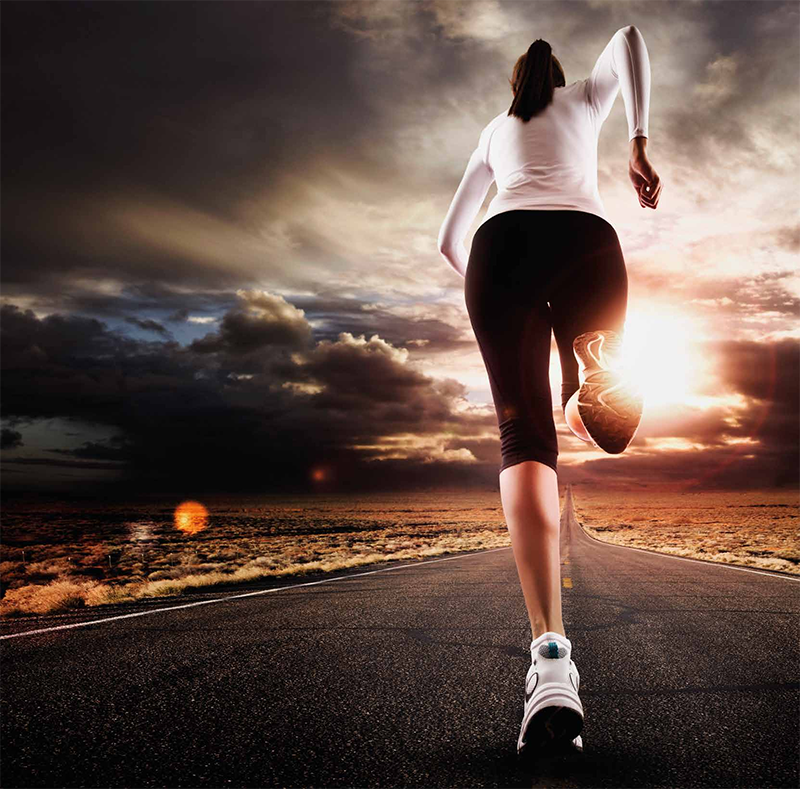Shift your exercise routine to sundown and you’ll beat the heat plus boost your fat burn and stamina. We’ve got all the safe-sweat tips and cool-gear picks for your new power hour.


Shift your exercise routine to sundown and you’ll beat the heat plus boost your fat burn and stamina. We’ve got all the safe-sweat tips and cool-gear picks for your new power hour.

Bright lights, big humidity? You could retreat to a climate-controlled gym for your workouts, but then you would miss out on some great outdoor escapes. Instead, embrace the after-hours run or bike ride and you’ll not only keep cool but also possibly amp up your results. When people exer cise in the evening, they are able to go 20 per cent longer than in the morning, research in the journal Applied Physiology, Nutrition, and Metabolism found. Your body has a greater ability to produce energy in the evening, thanks to a faster oxygen uptake that spares your body’s anaerobic reserves a bit longer, and your anaerobic capacity (how much energy you can produce without using oxygen) is at its peak at this time explains David Hill, the author of the study.
Nighttime exercisers also had larger increases in levels of cortisol and thyrotropin – two hormones essential for energy metabolism – than people who exercised at any other time of the day, according to a University of Chicago study. When cortisol is running high all day because of stress, it can increase abdominal fat storage. But during exercise, cortisol does a 180, becoming a fat-burning hormone as it breaks down carbs more efficiently, says Michele Olson, an exercise physiologist at Auburn University in the US. In other words, it turbocharges your calorie burn.
Another study, in The Journal of Sports Medicine and Physical Fitness, compared women who walked for exercise in the morning with those who did so in the evening, and found that even though both groups had roughly the same daily caloric intake, the women who walked later in the day burned more fat overall. Why?
The evening exercisers experienced greater hunger suppression and seemed to opt for a more protein-rich post-workout meal, shifting the distribution of their daily calories to the morning instead. Those actions were found to be protective against an increase in fat, says Andrea Di Blasio, the lead author of the study.
Follow these strategies to work out better after dark and the results may convince you to stick with the night shift.
START AFTER SUNSET
It’s not just the air that feels cooler at night; the ground does, too, says Patrick Cunniff, a cross-country and assistant track and field coach at the University of Georgia. When temps are above 30 deg C and the sun is shining, pavement and tracks can heat up to a sizzling 50 deg C. That heat radiates off the ground, making it feel as though you’re running in a sauna, Patrick explains. And high solar radiation raises the temperature of your skin, which forces your heart to work harder to try to keep you from overheating, thus sapping your endurance, new research in the European Journal of Applied Physiology revealed. To maximise your staying power and comfort, take off after dusk.
BUILD UP TOLERANCE
“It takes only three to four sessions for your body to acclimate to the humidity of mid-year hot nights,” says exercise physiologist Keith Baar, an associate professor at the University of California, Davis.
Despite milder temper atures, relative humidity (basically how much water the air holds) can be higher in the evening. This presents a sticky situation: Humidity causes you to sweat more and makes it harder to cool down, so any workout will feel harder than it should, according to research in the European Journal of Applied Physiology.
Even though the lower evening temps mean you have less body heat to dissipate in the first place, the solution is to ease in with a few light-exercise sessions. “Keep your pace one minute to 30 seconds slower than usual,” Keith says. If you typically do 5:30 per kilometre, start out at 6:30 per kilometre and up your pace by 10 seconds per kilometre for each of the next three outings.
DIVVY YOUR DINNER
Figuring out what to eat and when to fuel up for evening exercise can be a challenge. Should you squeeze in dinner before you head out? “It’s best to have something that’s about 200 calories and high in carbohydrate from grains, fruits and vegetables, or dairy; that contains some protein; and that’s low in fat and fibre, and to eat it one to two hours beforehand,” says Christy Brissette, a US-based dietitian and the president of 80 Twenty Nutrition.
If you like to eat on the early side, that could mean having part of your dinner before your workout and the rest after. Or if you typically eat later, opt for a snack such as yogurt with fruit or oatmeal with raisins or walnuts. Then an hour or so after your workout, eat a larger meal that has about 400 calories and a 2-to-1 ratio of carbohydrate to protein. Try a burrito with chicken or black beans, brown rice, avocado, lettuce and salsa in a whole-grain wrap. Or soup, stew or chilli with a protein, veggies and wholegrains. And be sure not to skimp on vitamin D in your daily diet from foods like oily fish, milk or fortified almond milk.
If you’re doing most of your workouts at night, you may be getting fewer of the sun’s UVB rays – meaning your body is producing less of this vitamin, which improves muscle function, helps prevent injury and lowers inflammation, Christy says.
DON’T HOLD BACK
Good news: You won’t be cheating yourself out of any much-needed sleep by going hard during your workout, even if you’re cutting it close to bedtime, studies show.
People who exercised vigorously for 35 minutes about two hours before bed reported sleeping just as well as on nights when they didn’t exercise, according to findings in the Journal of Sleep Research.
And when compared with morning exercisers, those who worked out at night actually slept more soundly and longer, a study at Appalachian State University in the US found. “Evening exercise warms up your core body temperature – similar to taking a warm bath before bedtime,” explains lead study author Scott Collier, “and that helps you to fall asleep quicker and to sleep better.”
LIMBER UP YOUR SENSES
Before you dash, spend 10 to 15 minutes warming up outside, so that your eyes can better adjust to the dark, suggests Fred Owens, a professor of psychology at Franklin and Marshall College in the US. The more acclimated your eyesight, the safer you’ll be.
Evening road traffic is at its busiest from 6pm to 9pm, making it the most dangerous time for pedestrians to be out. And we know you love your tunes, but it’s best to ditch them so you can listen for oncoming traffic. If you simply can’t seem to run without music, wear headphones that let in ambient noise, and keep the volume low.
LIGHT UP THE NIGHT
If you run roadside, wear reflective materials, which are illuminated by headlights, Fred suggests. For trail or park runs, opt for glow- in-the-dark materials. They’re the safest option, he says, because they’ll shine even without exposure to external light.
In both cases, the illumination or reflectivity on your clothes should be on the parts of your body that will be moving the most, such as joints, so drivers can more easily read the motion as that of a runner. Stick with the picks on the next page and you’re covered.























